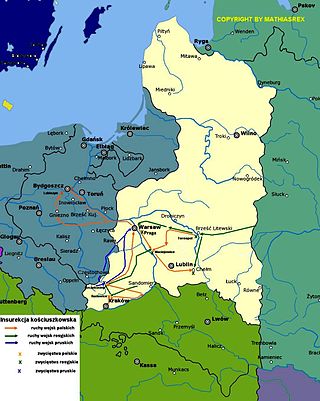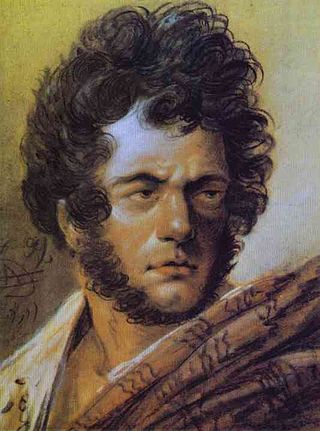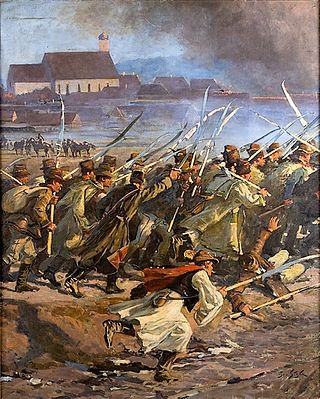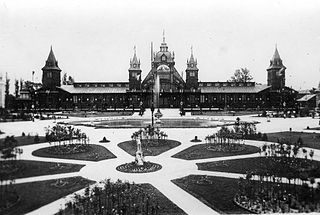
Wrocław is a city in southwestern Poland and the largest city and historical capital of the region of Silesia. It lies on the banks of the Oder River in the Silesian Lowlands of Central Europe, roughly 40 kilometres (25 mi) from the Sudeten Mountains to the south. As of 2023, the official population of Wrocław is 674,132 making it the third largest city in Poland. The population of the Wrocław metropolitan area is around 1.25 million.

Andrzej Tadeusz Bonawentura Kościuszko was a Polish military engineer, statesman, and military leader who then became a national hero in Poland, the United States, Lithuania, and Belarus. He fought in the Polish–Lithuanian Commonwealth's struggles against Russia and Prussia, and on the U.S. side in the American Revolutionary War. As Supreme Commander of the Polish National Armed Forces, he led the 1794 Kościuszko Uprising.

Jan Alojzy Matejko was a Polish painter, a leading 19th-century exponent of history painting, known for depicting nodal events from Polish history. His works include large scale oil paintings such as Stańczyk (1862), Rejtan (1866), Union of Lublin (1869), Astronomer Copernicus, or Conversations with God (1873), or Battle of Grunwald (1878). He was the author of numerous portraits, a gallery of Polish monarchs in book form, and murals in St. Mary's Basilica, Kraków. He is considered by many as the most celebrated Polish painter, and sometimes as the "national painter" of Poland.

The Kościuszko Uprising, also known as the Polish Uprising of 1794, Second Polish War, Polish Campaign of 1794, and the Polish Revolution of 1794, was an uprising against the Russian and Prussian influence on the Polish–Lithuanian Commonwealth, led by Tadeusz Kościuszko in Poland-Lithuania and the Prussian partition in 1794. It was a failed attempt to liberate the Polish–Lithuanian Commonwealth from external influence after the Second Partition of Poland (1793) and the creation of the Targowica Confederation.

The University of Wrocław is a public research university in Wrocław, Poland. It is the largest institution of higher learning in the Lower Silesian Voivodeship, with over 100,000 graduates since 1945, including some 1,900 researchers, among whom many have received the highest awards for their contributions to the development of scientific scholarship.

Aleksander Orłowski was a Polish painter and sketch artist, and a pioneer of lithography in the Russian Empire.

The Battle of Racławice was one of the first battles of the Kościuszko Uprising against Russia. It was fought on 4 April 1794 near the village of Racławice in Lesser Poland.

Jan Styka was a Polish painter noted for producing large historical, battle-piece, and Christian religious panoramas. He was also illustrator and poet. Known also as a great patriotic speaker - his speeches were printed in 1915 under the French title L'ame de la Pologne.
"National Museum of Poland" is the common name for several of the country's largest and most notable museums. Poland's National Museum comprises several independent branches, each operating a number of smaller museums. The main branch is the National Museum in Kraków, established in 1879. It has several hundred thousand items in its permanent collections, kept mostly at the Main Building at 3 Maja St., and partly in eight other divisions around the city.

The National Museum in Kraków, popularly abbreviated as MNK, is the largest museum in Poland, and the main branch of Poland's National Museum, which has several independent branches with permanent collections around the country. Established in 1879, the museum consists of 21 departments which are divided by art period: 11 galleries, 2 libraries, and 12 conservation workshops. It holds some 780,000 art objects, spanning from classical archeology to modern art, with special focus on Polish painting. In 2023, the museum was visited by over 1.65 million people, making it the third most-visited art museum in Poland and the 37th most-visited art museum in the world.

The Transylvanian Panorama other names Bem and Petőfi, Bem in Transylvania, Battle of Segesvár / Schässburg - village of Fehéregyháza, meaning White Church was a monumental panoramic painting depicting the Battle of Nagyszeben, during the Hungarian Revolution of 1848-49.

The National Museum in Wrocław, established 28 March 1947 and officially inaugurated on 11 July 1948, is one of Poland's main branches of the National Museum system. It holds one of the largest collections of contemporary art in the country.

Feliks Michał Wygrzywalski was a Polish painter remembered primarily for his Orientalist scenes and portraits. He also created a significant number of nudes. His son, Feliks Kazimierz Wygrzywalski, was also a painter.
Franciszek Ksawery Niesiołowski was a colonel in the 6th Lithuanian Foot Regiment, general in the Kościuszko Uprising, the Army of the Duchy of Warsaw, and the Army of the Kingdom of Poland, served during the November Uprising, became a member of the Sejm in 1830, and was Senator-Castellan of the Kingdom of Poland from 8 August 1831.

Timothy with his Grandmother Lois or The Prophetess Anna Teaching a Child is a 1650 or c. 1654 oil on canvas painting, attributed to Rembrandt until 1910 but since 1924 thought to be by Willem Drost. Its two titles refer to Timothy, Lois and Anna. It is now in the Hermitage Museum, in Saint Petersburg.

Portrait of a Clergyman is a c.1650 oil on canvas painting long attributed to Rembrandt but now attributed to Helmich van Thweenhuysen II, a Dutch painter active in Gdansk. It has been in the National Museum in Wrocław since 1947.

2nd Kraków Grenadier Regiment was a scythemen regiment of the insurrection army during the Kościuszko Uprising in 1794.

The General National Exhibition in Lviv was a national exposition held in 1894 in the city of Lviv on the centenary of the Kościuszko Uprising. Its aim was to showcase the economic and cultural achievements of Galicia and to present the works of art of the Kingdom of Galicia and Lodomeria as well as all other Polish lands under foreign rule.

Romuald Giedroyć was a Polish-Lithuanian prince from the princely Giedroyć family, who fought in the Bar Confederation, War of 1792 and the Uprising of 1794 as part of the Grand Ducal Lithuanian Army. From mid-1812 to early 1813, Giedroyć was also the commander of the Polish-Lithuanian regiments raised during the French invasion of Russia. In early 1813, he was captured by the Russians and exiled to Arkhangelsk. In 1815, Alexander I of Russia amnestied Giedroyć and made him a Lieutenant general of the Army of Congress Poland.

Kościuszko at Racławice is an oil painting of the Battle of Racławice of 1794, painted by Jan Matejko in 1888, exhibited in the Gallery of 19th Century Polish Art in the Sukiennice Museum (Kraków).
































